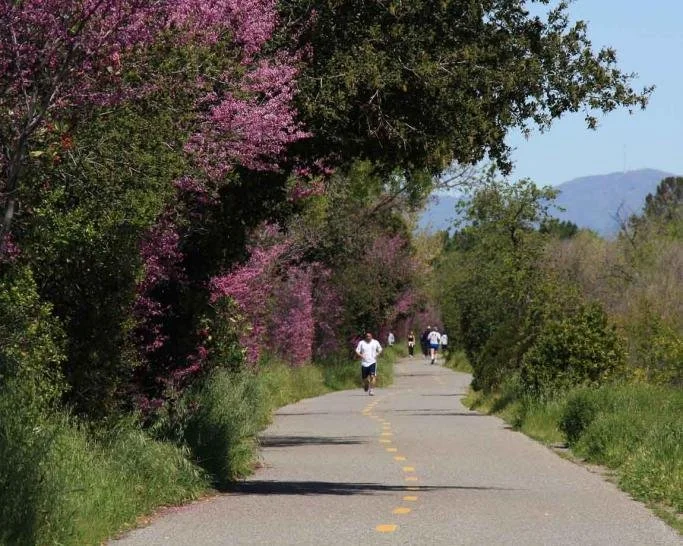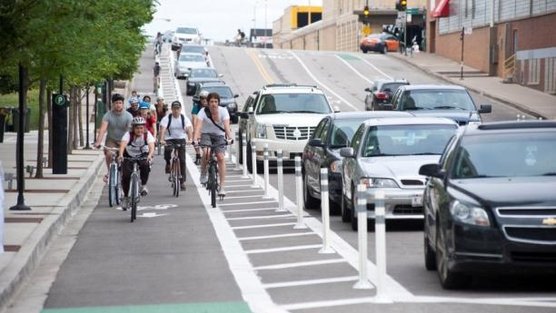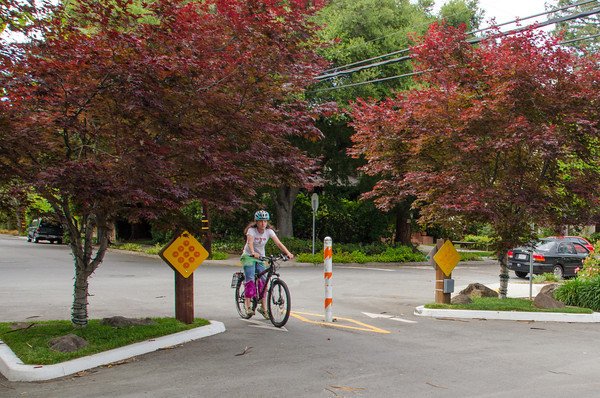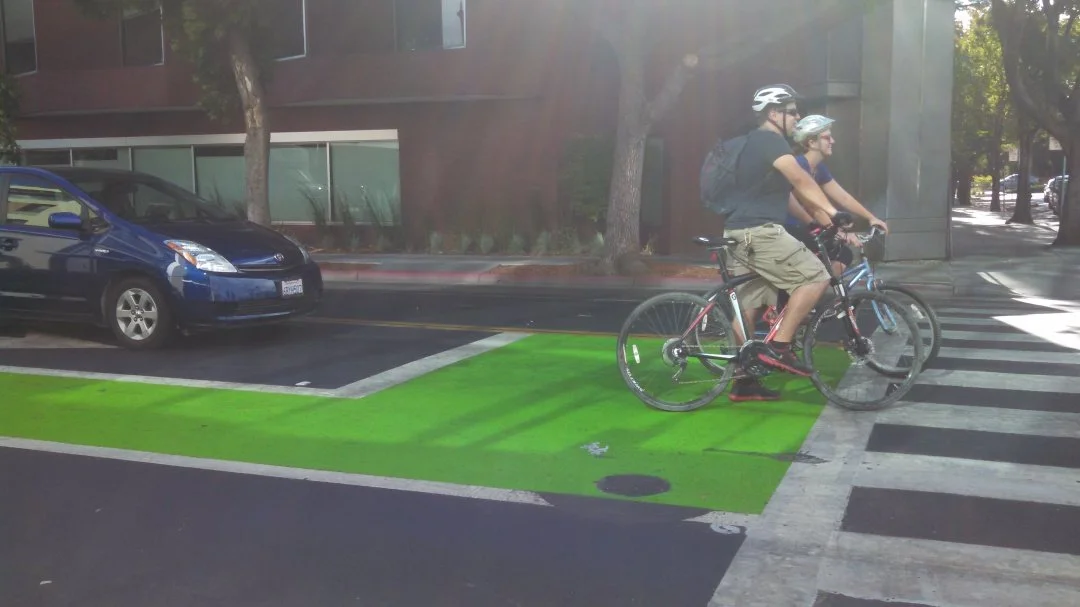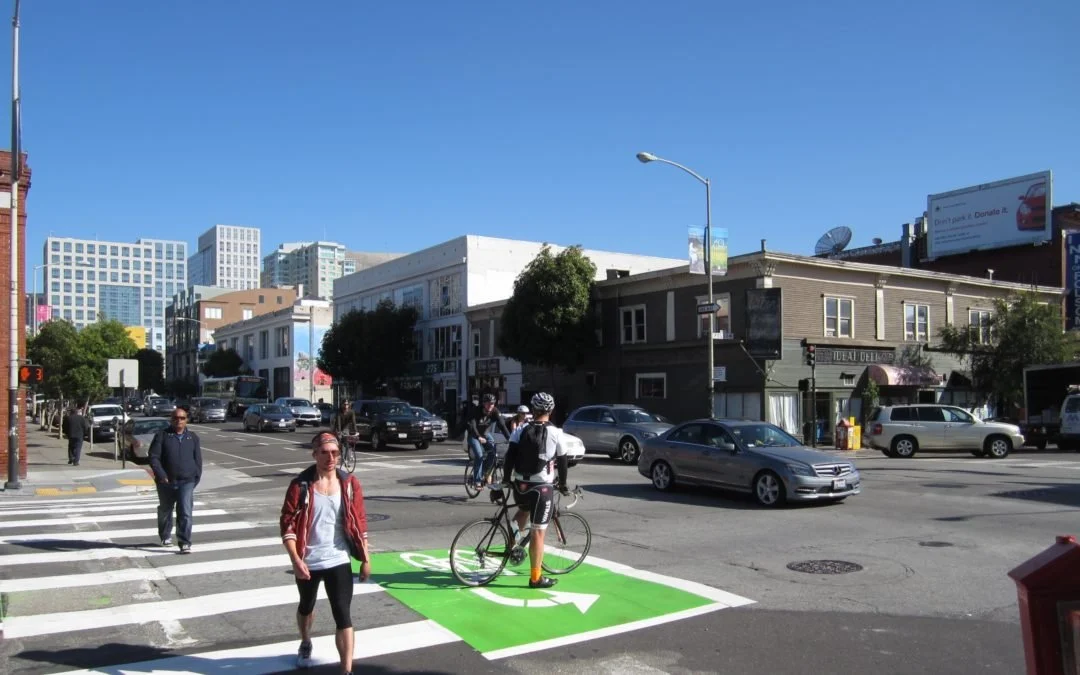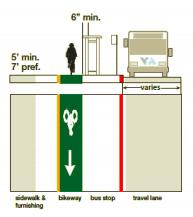Bikeway Design
There are currently four types of bicycle facilities classifications specified in Chapter 1000 of the California Highway Design Manual (HDM) (discussed below) which also works with the California Manual on Uniform Traffic Control Devices (MUTCD) Part 9.
However, California has recently endorsed the National Association of Transportation Officials (NACTO) Urban Street Design Guide and Urban Bikeway Design Guide as resources that Caltrans and local entities can reference when making planning and design decisions, as long as they are thoroughly documented. These guidelines allow much more flexibility and are tailored to the urban and suburban challenges we see in our region. Check out Caltrans’ 2017 guide to accommodating bicyclists and pedestrians on California’s transportation system, which features some of the newer bike designs.
SVBC has also endorsed NACTO’s guidelines as well as the Valley Transportation Authority’s (VTA) Bicycle Technical Guidelines.
Class I:
Class I bicycle facilities are off-road paths and trails. Often, this takes the form of multiuse trails. The defining aspect is that they are not on streets shared with vehicles, but separate places for bikes and other recreational uses. California’s Highway Design Manual says that the minimum width of travel way for a two-way bike path shall be 8 feet, 10-foot preferred. Where heavy bike or pedestrian traffic is expected, the Highway Design Manual recommends 12 feet or more.
SVBC supports the implementation of Class I facilities of at least 12 feet and strongly urges jurisdictions to have such facilities start and end near popular origins and destinations. The construction and future improvements of such facilities should also consider where the off-road path intersects with streets and other bike facilities and create good connections to these trails. This may require traffic signals or other devices to prevent conflicts. For reference on design standards, please see VTA’s Bicycle Technical Guidelines.
See our position on multiuse trail behavior and best practices.
Class II:
Class II facilities designates an on-road bicycle lane. Width and other characteristics can vary. Class II bike lanes are typically 5-6′ wide. These standard bike lanes can also include a painted “buffer” of 2-4′.
SVBC promotes the use of these types of bike lanes in all situations in which roadway space is available. Class IV protected bike lanes (below) provide the most protection and comfort for people on bikes and do the most to encourage a broad range of users.
SVBC also promotes the use of green dashed blocks to highlight conflict areas, such as when a car is merging from a through lane to a turn lane or when driveways cross bike lanes.
Class III:
This label applies to bicycle routes, which are preferred routes for people on bikes as compared to other alternatives. These are shared facilities with vehicles and other road users. They are often marked by signs appointing them as such and often include sharrows (see below).
SVBC urges jurisdictions to designate Class III facilities only where Class II or IV facilities are not feasible and traffic conditions are appropriate.
Class IV, Protected bike lane:
A protected bike lane is one that is physically separated from the vehicle travel lane by more than the white stripe. This can entail grade separation, flexible bollards or permanent barriers. California State Assembly Bill 1193 created this new class of bikeway facilities in 2014. Protected bike lanes provide the most protection and comfort for people on bikes and do the most to encourage a broad range of users. See Caltrans’ Class IV Bikeway Guidance for more information on specifications and our Protected Bike Lanes factsheet for the benefits of these facilities.
This video, by local bicyclist Joey Rozier, highlights the many different types of urban bike infrastructure as seen in San Jose.
Sharrows:
These are shared-lane markings that are indicated with a double chevron and bicycle stencil. They are used to designate that vehicles and bicycles should share roadway space. They can also specify where in the roadway a bicyclist is expected to ride.
SVBC promotes the use of sharrows on narrow, low-traffic, residential streets OR in the center of the far right lane on a street with two lanes in both directions.
They should always be placed outside the door zone of parked vehicles and are best when in the center of the travel lane.
Bicycle boulevards:
Bicycle boulevards are streets that are designed to prioritize bicycle transportation. This is achieved through a number of traffic-calming strategies. They are typically low-traffic, residential streets with low motorized traffic speeds. Bicycle boulevards are usually signed and facilitate bike travel. The first bicycle boulevard in the nation was in Palo Alto: Bryant Street. Other cities quickly followed suit. These are a great way to make streets more accommodating for bicyclists without creating separate bike lanes.
SVBC supports more bicycle boulevards in our communities as they are an implementable project. Bicycle boulevards are best when on a grid network prioritizing one through route for bicycle travel. They should be more than a few blocks long.
Refer to Palo Alto’s bicycle and pedestrian plan for criteria for designation and design.
Bicycle boxes:
A bicycle box is a designated area, often painted green, at the head of a traffic lane at a signalized intersection for bicyclists. This provides a safe waiting area for bicyclists when stopped at a red light in which bicyclists are more visible to cars. This is a solution to the potential for “right hooks” when a vehicle is turning right across a bike lane. It can also allow a bicyclist to move from a right side bike lane to the left side of the traffic lanes in order to turn left.
SVBC promotes bike boxes that include instructional signage in appropriate situations.
Refer to the NACTO guidelines for more information on suitable circumstances and design.
Two-stage turn box:
Photo credit: SFMTA
Two-stage turn boxes offer people biking a formal way to make two point left turns at intersections from a right side bike lane. This permits the person biking to stay in the bike lane and other bike facilities rather than cross one or more lanes of car traffic to turn left. It also makes it easier to turn left from a protected bike lane.
Refer to the NACTO guidelines for more information on suitable circumstances and design.
Bikeways at bus stops
Often bus and bike traffic is in conflict for curb space. VTA has developed a guide to bikeways + bus stops. See its memo from November 2020 with design details here.

